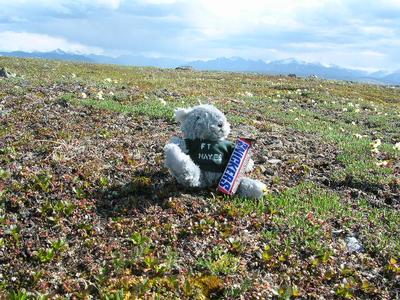13 June, 2004
Hours of sunlight: 24 (again)
Precipitation: afternoon squall of hail and rain
Sunday is a day for rest (or play) at Toolik Lake. Breakfast starts
at 9:00 a.m., many people go hiking up nearby mountains, lunch is
leftovers and even the most dedicated workers only put in half a day
of work (of course, some workdays are 18 hours long!)
While Penney, Amanda and Yo worked on scientific papers (think:
science fair report, only lots more detailed and considerably more
complex) I hiked up Jade Mountain, the mountain to the west of camp.
It was an extraordinary hike for lots of reasons.
To begin with, the horizon stretched for miles, and wave after wave
of clouds broke against the Brooks Range in the background.
Hiking through the tundra was beautiful (if tricky) - Dozens of
different kinds of flowers are in blossom, scattered thickly over the
tundra.
The vegetation grows so thickly that walking on the tundra is a bit
like walking on basketballs.
As always when hiking, I brought my bag of essentials: water, food,
compass, signaling mirror, first aid, knife, iodine tablets to purify
water, rain gear, etc. Bringing all this equipment on a short hike
may seem like a bother, but because we are so far away from help, it
is important to be prepared.
On the way down the mountain, the wind shifted direction and a storm
blew in from the south. Thunder rolled across the tundra, reflecting
off the face of Jade Mountain. I put on rain gear as the first drops
fell and, within minutes, hail started pelting the ground.
Fortunately, I was walking with my back to the wind - The rain and
hail jumped off my jacket, but would have hurt if they had been
bouncing off my face.
Electron Capture Detector
The electron capture detector is the piece of equipment that measures
the types of gasses coming out of the gas chromatograph.
To understand the gas chromatograph, it may be helpful to imagine a
football quarterback throwing passes to a receiver downfield. When
the receiver catches the ball, a touchdown may be scored. In some
cases, the football is intercepted by a member of the opposite team
and doesn't reach the receiver at all.
And what does football have to do with analytical chemistry, and
specifically electron capture detectors?
The electron capture detector uses a piece of foil made from
radioactive nickel (quarterback) which gives off a stream of beta
parcticles (high-energy electrons) (footballs). Ordinarily the
electrons reach the receiver on the other side of the ECD, except
when a gas gets in the way (interceptor). By throwing lots of
electrons each second (about 6,000), even a gas passing through the
detector quickly will intercept some of those electrons. When the
receiver receives fewer electrons, it generates a lower current. The
drop in current is recorded by the computer (or rather, computers
that work) and analyzed by us.
Interesting fact to make you smarter:
You are exposed to radiation everyday: from the sun, from small
amounts of naturally-occurring radioactive rocks, etc. Dentists and
doctors cover you with a lead shield when X-raying teeth or broken
bones to prevent the very strong X-rays from damaging other parts of
your body.
Radiation exposure is sometimes measured in "disintegrations per
minute", and sometimes in "curies" (named after Marie Curie, a Nobel
Prize winner in chemistry and in physics for her pioneering work with
radiation).
--

1. horizon on the tundra stretches for miles

2. Storm clouds broke against the Brooks Range like waves on the beach --

3. Dozens of different kinds of flowers are in blossom, scattered thickly over the tundra.

4. Be prepared

5. Caught in the rain and hail

6. electron capture detector --
Contact the TEA in the field at
.
If you cannot connect through your browser, copy the
TEA's e-mail address in the "To:" line of
your favorite e-mail package.
|
